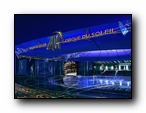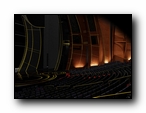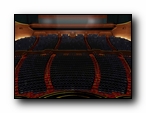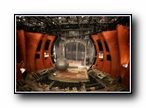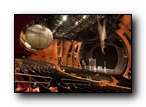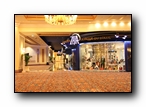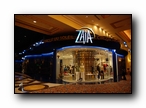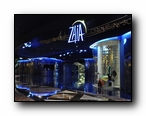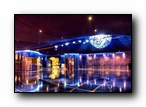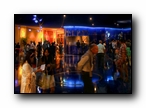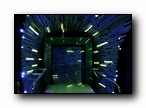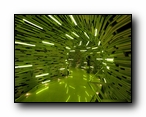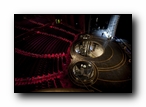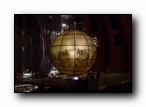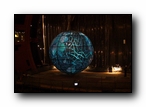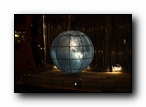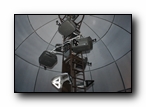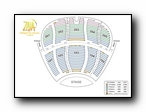
![]()
[ You are here: Grand Chapiteau | Creations | ZAIA | Scénographie ]
Création
Expérience
Réserve RetiréOdyssey
The ZAIA Theatre is reminiscent of ancient architectural telescopes such as Jaipur in India and the vast stone Mayan observatories of Central America. It is not a planetarium as such, however it contains many visual cues and references that add to the show’s underlying theme of cosmic exploration.
|
In keeping with the primary theme of a journey into space, verticality is an important component of the show and the theatre was designed with a higher than 80-ft/24-meter ceiling and the set elements are intended to recreate the experience of being in space - an experience that is both mysteriously alien and strangely familiar. This is a timeless journey from through the stratosphere and beyond, while keeping an eye on Earth.
When the audience enters the theatre, one of the main set elements, a gigantic Sphere, appears to be a chandelier and the walls are illuminated by light sources at ground level, creating the mysterious effect of a deep dark cavern. When the Sphere is revealed in all its constantly-changing glory following the opening number, its full scope and the effect of its trajectory over the heads of the audience is nothing less than stunning.
The proscenium is almost circular, like an oculus (a round window, sometimes called a “bulls eye”) made up of several layers that create a sense of depth through perspective lines and curves made of bronze that converge on the single focal point located at the centre of an enormous sun set against the backdrop, known as the “Star Drop,” which recreates the night sky with 3,000 fiber optic “stars.” Designer Guillaume Lord used a star map to give the Star Drop an accurate representation of the constellations at the exact location of the theatre.
The Sphere houses six projectors that beam images onto its six segments through a full 360 degrees. The individual projections take into account the curvature of the Sphere and are stitched together seamlessly to give the appearance of a series of single images. This sculptural mosaic transforms into a lantern, a hot air balloon, the earth and the moon, depending on the requirements of the show.
Some Figures:
- The theatre has a seating capacity of 1,852.
- The Proscenium is 88-ft high and 97-ft Wide.
- The 12,221 sq. ft. Star Drop measures 121-ft x 101-ft.
- The polished bronze-plated Sun has a 20-ft diameter.
- Above the audience the 48-ft x 95-ft Oval Track transports performers and set elements (such as the 600-lb "ice" blocks) on 5 chariots that weigh 800 lbs.
- It takes 30-40 backstage technicians to operate the set.
- The 25-ft-diameter Sphere has an aluminum exoskeleton, a projection surface, weighs 4,000 lbs and moves through three axes.
| Sound Design |
ZAIA is the latest in a series of breathtaking spectaculars from Cirque du Soleil. The 90-minute production, presented in a custom-built, 1,800-seat theater at the Venetian in Macao, represents Cirque du Soleil's first resident show in Asia. As with all Cirque du Soleil productions, ZAIA melds acrobatics and inventive visuals with otherworldly sonic landscapes to create a uniquely multisensory experience. And one of the keys to creating that experience is the use of Meyer Sound's innovative and creative digital audio tools and loudspeaker technology.
The show is based upon the theme of the dream of a young girl who journeys into space. The image of the sound source continually shifts to follow her perspective, moving from the stage into the house, utilizing the vast depth of the theater's eight- story-high ceiling. The system employs a sophisticated integration between the Matrix3 audio show control system, Constellation electroacoustic architecture, and the Galileo loudspeaker management system, with the sounds mapped through the Matrix3 system sent to 115 Meyer Sound loudspeakers located throughout the house. The Matrix3 also functions as the mixing console for the show, providing a fully integrated digital audio environment for ZAIA.
The sound designer for ZAIA, Steven Dubuc, who is also a veteran of other Cirque productions including Zumanity, KÀ, and The Beatles LOVE, points to Constellation as a means of enabling much of the show's sonic signature. "Constellation allows us to change the acoustics of the room," says Dubuc. "Since we can't place any baffles or acoustic treatments that would interfere with the show's acrobatic elements, this is critical. Constellation is also used in certain scenes, where we want to create a larger-than-life ambience, to create an impression of traveling through space and time."
The audio system for ZAIA was provided by Montreal-based Solotech, the production partner behind almost all of Cirque du Soleil's shows. In addition to the CueConsole control surface, 11 Matrix3 units, six Constellation processors, and 15 Galileo 616 processors, Solotech also provided a vast assortment of Meyer Sound self-powered loudspeakers strategically positioned throughout the venue, including a main system comprising 18 MICA line array loudspeakers and eight 700-HP subwoofers. The theater also features two SB-2 parabolic wide-range sound beams and a number M1D, MILO and M'elodie line array loudspeakers, along with UPJ-1P VariO loudspeakers, Stella installation and CQ-2 loudspeakers.
As Eric Poitevin, the Venetian's head of audio, observes, Cirque du Soleil's reputation for excellence is not achieved by chance. "Cirque du Soleil demands precision and consistency for every aspect of a production. They provide you with the best tools in the world, and they expect the same results in return," Poitevin says. "We run 457 shows a year, and there's no margin for error."
According to Dubuc, who worked closely with assistant Jason Rauhoff and Solotech's Bob Barbagallo in the production, the role of Meyer Sound in his toolbox cannot be understated. "Sound design is one of the places where technology meets art," Dubuc reflects. "My job as a sound designer is to merge the composer's musical vision with a soundscape that complements the show itself. With Meyer Sound, I can utilize 150 different sources to color the music, to localize it, rather than simply having it come from left or right. It's a dramatically expanded creative palette, and that leads to a truly rewarding collaboration."
